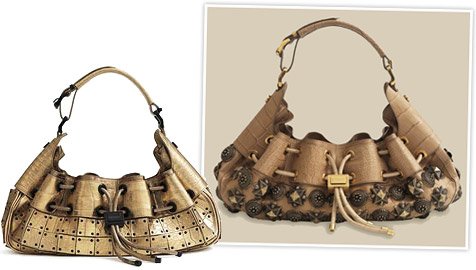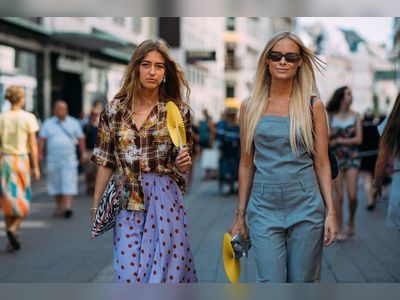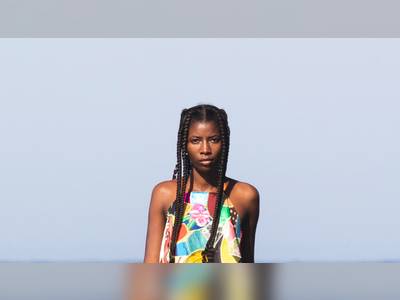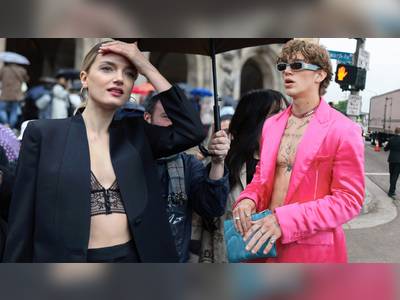It is called the Warrior and it costs £13,000. It is not a small car, nor an artwork. And by this time next year, its owner will want a new one. This is the latest handbag by Burberry, a British fashion house previously best known for classic trench coats.
So what could possibly justify this stupendous price tag? Well, let's have a look at this baby. A nice slouchy crescent shape, the Warrior has drawstrings and snazzy armour-plating. It's cut from gold alligator skin – gold-painted, one assumes, although if Burberry had chosen to plate it with the 24-carat stuff, they wouldn't have been the first to bejewel a bag.
In December, Chanel introduced its Forever bag, which is not only cut from alligator skin but has a clasp studded with 334 diamonds. Its price? A shade over £100,000. Last year, there was the Louis Vuitton Tribute Patchwork bag, a creation that earned the nickname "Frankenstein's monster" in the fashion press but still carried a £23,484 price tag. And sold out.
These are what the fashion industry, with atypical understatement, term "luxury bags". But who is buying them? As the American economy wavers and the credit crunch bites, you might assume that the demand for exorbitantly priced reticules will plummet.
But the super-rich who buy bags like the Warrior – and, though fashion houses are notoriously discreet, they do admit that most orders come from the Middle East, Russia and Texas – seem immune to anything as banal as belt-tightening. They feel no guilt when the likes of Harriet Harman thunder, as she did on Newsnight last year: "Do we want to be a divided society where some people struggle and others spend £10,000 on a handbag?" They just want a bag that will make their girlfriends really, really jealous.
Burberry won't say how many Warriors will sell, but it confirms that several have been ordered already and there is a healthy interest from clients who "don't seem to mind such prices".
What those clients do mind, apparently, is shopping with the plebs. The "luxury bags" are sold either at private appointments or at special invitation-only events attended by women whose credit is matched only by their love of alligator skin. Burberry says it held such a party at its London store, where ladies chose their bags and had them engraved with their initials. The bags were later delivered to their homes in quilted boxes. Similar events were held in Las Vegas, Beverly Hills, Milan, Rome, Madrid, Kuwait and Moscow.
The allure of these bags is their scarcity. So, yes, they're made from alligator, ostrich or snakeskin, and might be studded with jewels – but, more than that, they're produced in tiny numbers. When every other woman on the street owns an "entry level" Prada nylon bag or totes a fake Balenciaga Lariat on her arm, the customer with more ample financial means turns her nose up at mere off-the-shelf It bags.
"That whole phenomenon has changed," Julie Gilhart, fashion director of Barneys New York, told The New York Times. "Our customers seem to be looking for something more interesting. They don't want to spend money on something everyone else has."
Spending £13,000 on a handbag might seem offensively profligate, but it is emblematic of a bag mania that has gripped women of more average means. According to recent surveys, British women own between four and 14 handbags and are prepared to spend, on average, up to £380 per bag. A more conservative survey by Mintel showed that 55 per cent of women have bought a handbag in the past 12 months. Handbag sales in the UK have gone up by 146 per cent in the last five years.
The reasons are straightforward; handbags convey status both financial and fashionable, do not require a size four figure, and are utterly frivolous. "People want to spend their money on frivolous things," says Pamela Danziger, author of Why People Buy Things They Don't Need and founder of the research company Unity Marketing. "Handbags definitely fall into that category."
No wonder the handbag has become the top fashion signifier. There had long been expensive bags, courtesy of the likes of Chanel and Hermès (whose classic designs were born in the 1950s). But the It bag pandemic began in 1997 with the Baguette, a small, squishy bag by the Rome fur and accessories house Fendi that was designed to be carried under the arm like a stick of bread. Celebrities started carrying the little clutch, and the It bag's concomitant irritation, the waiting list, also arrived.
The Baguette's designer, Silvia Venturini Fendi, has since said she could never have predicted that it would be a hit – although she managed to follow up with the Spy and the B bags. This year, the company has produced an anniversary model of the Baguette, in canvas – and, predictably, there is a top-end made-to-order model. This time, amusingly, it's the box (in snakeskin, or any rare leather you choose) rather than the bag that pushes up the price, which starts at £21,000.
Women have long been attached to their handbags, for reasons that Freud and others were moved to guess at. Classical analysis believes that a dream of a stolen purse signifies the missing penis, which isn't much comfort to a woman who's been beaten to the top of the Hermès Birkin waiting-list). Anna Karenina signals she is about to end it all by tossing aside her red handbag. The Queen and Mrs Thatcher both use handbags as part of their armour. More contemporarily, blogs such as Baglady, Bagsnob and Purseblog, which debate the appeal of each new must-have, have helped to create a sophisticated status code that transcends language barriers. Or, to look at it from another angle, make us look very foolish indeed.
"I bought three Chloé Paddington bags, which of course no one carries any more," the actress Donatella Panayiotou told the Daily Mail last year. "And I bought a Dior saddle bag in every colour. Again, they aren't fashionable any more, so I can't use them."
Within the fashion industry many privately hope that the trend must soon run its course. Open any fashion magazine, and even the new spring/summer ad campaigns are solely focused on marketing the bags that are clasped close to near-naked celebrity or model bodies. Clothing gets, at best, a walk-on role.
Nowhere is the pre-eminence of the bag more apparent that at catwalk shows. The magazine editors in the front rows of Milan fashion shows have for several seasons been rolling their eyes as yet another luxury goods house with its mind on profit margins sends out every model with a sack-sized handbag adorned with chains, padlocks, tassels, flowers and gewgaws.
There was a sense of inevitability about the appointment of Frida Giannini to the top job at Gucci back in 2005; she may have had no experience as a fashion designer, but she had proved her worth as the creator of the Flora range of bags. The appointment seemed to signal that, at Gucci at least, expertise in accessories now trumps tailoring know-how.
Bags, you see, are very profitable. They are the fastest-growing sector of the fashion market, they take up little space in stock rooms, and clients need to replace them each season. And, year on year, designers have pushed the prices up far beyond inflation; Burberry reported that the average price point of a bag has risen by 25 per cent in the past year. The most basic version of the Warrior, in plain calfskin leather, costs £1,195. That's considered "entry level". No wonder the numbers of female British bankrupts are up.
The fashion equivalent of $100 per barrel of oil happened a few years back, when the average It bag in mass production broke through the $1,000 mark. Selfridges reports that the average price of designer bags is now £850, a rise of 55 per cent since 2005. Luxury goods companies are testing the laws of economics.
But, as "entry level" bag addicts are made to choose between mortgage repayments or the new Mulberry Henley, there are more signs that the It bag must soon start losing it. Subtle signs of handbag fatigue, or at least a waning aspiration for the most expensive totes, appeared late last year. The Anya Hindmarch "I'm not a plastic bag" caused stampedes and created a less-than-charitable resale economy on eBay. Kate Moss was photographed, twice, carrying a charity bag produced by Superdrug. Lauren Bush's "Feed" bag, made from nothing less glamorous than hemp, was launched in December.
This spring, the proudly vegan Stella McCartney has teamed up with LeSportsac to produce a range of nonleather bags, none of which will cost more than £125. "That $5,000 (£2,500) Marc Jacobs bag is so yesterday's news," Elizabeth Kiester of LeSportsac told The New York Times. "The luxury market is so over the top now that it is demented. I call them limo bags. I don't have a limo."
In fact, visitors to the Greenwich Village shop of Marc by Marc Jacobs, the younger line of the American designer, are often surprised to find limited-edition runs of simple cloth shoppers selling for less than £10.
"It's only a very small minority, obviously, buying the very expensive bags," says Katrin Magnussun, Mintel's senior retail analyst. "But there is also a majority here in Britain that are happy to buy five bags a year at £20 each. Copies of designer bags are also driving the market, and at this end of the scale, there are affordable bags that you can buy for £2.50 and throw away when you are bored with them."
True label snobs, meanwhile, note that Balenciaga, the most elite house and often cited as the fashion insider's label, has a policy of never featuring its (soaraway successful) bags in its ad campaigns. So, if you feel that a £13,000 bag made from a majestic predator or a £2.50 copy from Primark isn't much of a choice, perhaps it's better to do what both Carine Roitfeld, editor of Paris Vogue, and Anna Wintour, her counterpart in New York, both do – they don't bother carrying one at all.











